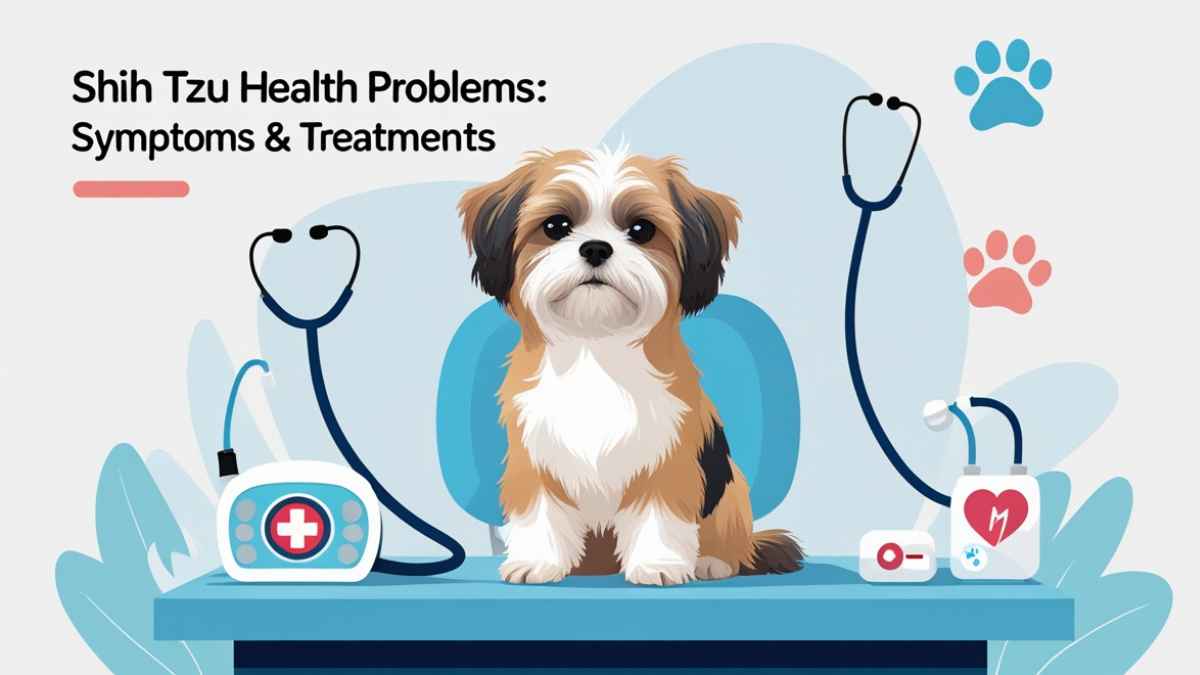10 Common Health Problems for Shih Tzu Dogs (Symptoms & Treatmen)

Shih Tzus are one of the most beloved toy dog breeds in the world. Their sweet temperament, luxurious coat, and charming appearance make them a favorite companion in many households. But beneath their adorable exterior, Shih Tzus are prone to a unique set of health issues due to their distinct body structure and genetics. Understanding these health problems is essential for owners to provide proper care, avoid future complications, and ensure a long, healthy life for their furry companion.
What are health problems for Shih Tzu?
Health problems for Shih Tzus refer to breed-specific medical conditions that affect various systems of their body. These include respiratory, dental, ocular, joint, and skin issues, many of which are linked to their flat-faced (brachycephalic) skull shape, compact body, and dense coat. While not all Shih Tzus experience every condition, many are genetically predisposed, making early detection and preventive care vital.
Why health awareness is important
Being aware of these health issues can be a lifesaver. Shih Tzus can’t always communicate discomfort clearly, and minor symptoms may quickly escalate. Knowing what to watch for helps prevent pain, avoid expensive emergency care, and improve your dog’s overall quality of life. It also enables owners to make informed choices about grooming, diet, and exercise.
1. Brachycephalic Airway Syndrome
One of the most well-known Shih Tzu health issues, this syndrome is caused by their short, compressed nasal passages. It makes breathing harder, especially during warm weather or strenuous play. Signs include snorting, wheezing, and frequent panting. In severe cases, the dog may faint from exertion. Treatment options range from weight management and avoiding heat to surgical correction of the nostrils and soft palate.
2. Eye Problems
Their prominent eyes are beautiful, but vulnerable. Shih Tzus often develop conditions like corneal ulcers, dry eye, cherry eye, and cataracts. These issues can cause discomfort and, if left untreated, lead to vision loss. Common symptoms include excessive tearing, squinting, eye rubbing, or cloudy pupils. Daily eye cleaning and regular check-ups with a veterinary ophthalmologist can reduce the risks significantly.
3. Dental Disease
Shih Tzus have small jaws with crowded teeth, which creates the perfect breeding ground for plaque and tartar. If oral hygiene is neglected, periodontal disease can set in early, leading to pain, infections, and even tooth loss. Symptoms include bad breath, bleeding gums, and loose teeth. Daily brushing, dental chews, and routine cleanings are critical to maintaining dental health.
4. Luxating Patella
Luxating patella is a condition where the kneecap dislocates from its normal position. This is a hereditary concern in many small breeds, including Shih Tzus. Affected dogs may limp or skip steps while walking. The condition can worsen over time, leading to arthritis. Mild cases can be managed with weight control and physical therapy, while severe cases may require surgery.
5. Hip Dysplasia
Though more common in larger dogs, Shih Tzus are not immune to hip dysplasia. This involves malformation of the hip joint, leading to instability, inflammation, and pain. Dogs with this condition may struggle to rise or show reluctance to exercise. Treatment options include anti-inflammatory medications, joint supplements, and in extreme cases, hip replacement surgery.
6. Intervertebral Disc Disease (IVDD)
This painful spinal condition is caused by degeneration of the cushioning discs between vertebrae. Affected dogs may yelp when picked up, walk with a hunched back, or lose mobility in their hind legs. IVDD requires immediate veterinary attention. Treatment may involve crate rest, pain relief, and in some cases, surgery. Avoiding jumping from furniture can help prevent injury.
7. Allergies
Allergies are one of the less obvious but very common Shih Tzu health issues. These can be environmental (pollen, dust), food-related (certain proteins or grains), or caused by fleas. Symptoms include constant scratching, skin redness, and recurrent ear infections. Diagnosis usually involves elimination diets or allergy testing. Management includes anti-itch medications and special shampoos.
8. Ear Infections
The long, floppy ears of a Shih Tzu create a moist environment ideal for yeast and bacteria. Ear infections can become chronic if not addressed promptly. Watch for signs such as head shaking, foul odor, and brown or yellow discharge. Cleaning ears weekly and keeping them dry after baths is essential in prevention.
9. Hypothyroidism
Hypothyroidism is a hormonal condition where the thyroid gland underproduces crucial hormones. It leads to weight gain, lethargy, cold intolerance, and a dull coat. A simple blood test can confirm the diagnosis. Lifelong daily medication can manage the condition successfully, often restoring energy levels and coat health.
10. Bladder Stones
Bladder stones form when minerals crystallize in the urinary tract. They can cause pain, difficulty urinating, and even blockages. If your dog strains during urination or has blood in the urine, immediate veterinary attention is required. Treatment may involve a special diet, medication, or surgery, depending on the size and type of stone.
Genetic Concerns and Inherited Conditions
Aside from the above issues, Shih Tzus are genetically predisposed to several other conditions like renal dysplasia and progressive retinal atrophy. These may not show symptoms until later stages. Responsible breeders often test for such conditions to minimize risk in litters. As an owner, regular health screenings are the best defense.
Benefits of Early Detection
Spotting issues early has undeniable advantages. Treatment is often more effective in initial stages. You also avoid emergency situations and provide your Shih Tzu with a better, longer life. Regular vet visits, keeping a health diary, and being attentive to behavioral changes can go a long way.
Care Tips and Preventive Measures
A healthy lifestyle plays a key role in minimizing Shih Tzu health issues. Feed a balanced, high-quality diet, ensure regular grooming, and exercise your dog moderately. Keep up with vaccinations, deworming, and flea control. Also, create a calm, clean living environment to reduce stress and infection risks.
When to See a Vet
If your Shih Tzu shows signs of breathing difficulty, unusual discharge, limping, or behavioral changes, don’t wait. Early intervention can be the difference between a manageable issue and a life-threatening one. Schedule wellness exams at least twice a year, and more often for seniors.
Grooming as a Health Strategy
Grooming isn’t just about beauty—it’s health maintenance. Regular brushing prevents matting that can irritate skin. Bathing keeps infections at bay. Cleaning eyes and ears protects against painful problems. Nail trimming ensures healthy movement. All of this adds up to a healthier Shih Tzu.
A Note on Shih Tzu Life Expectancy
With proper care, Shih Tzus can live 12 to 16 years. Genetics play a part, but lifestyle is just as crucial. Many health issues can be managed or entirely avoided with early action and consistent care.
Conclusion
Shih Tzus are a joy to own, but their health needs require proactive attention. Recognizing the top 10 Shih Tzu health issues and knowing how to respond is not just good pet parenting—it’s essential. With love, awareness, and proper care, your Shih Tzu can enjoy a long, comfortable, and happy life.
Stay ahead of health concerns—book your Shih Tzu’s vet check-up today and give them the life they deserve.




